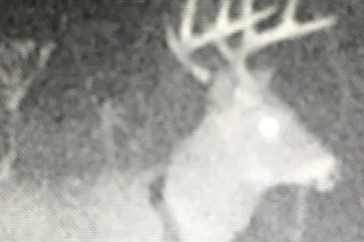The Buck Stops Where? UNH Research Records Longest-Ever Deer Distance

Fleeting glimpse of an adult white-tailed deer, known as N17003, that traveled the longest distance ever recorded by a UNH researcher – over 200 miles in 22 days. Credit: Missouri Department of Conservation
DURHAM, N.H.—Why did the deer cross the road? According to research from the University of New Hampshire to keep going and going and going. Researchers have discovered the longest distance ever recorded by an adult male white-tailed deer—300 kilometers, or close to 200 miles, in just over three weeks. The finding has important implications for population management and the transmission of disease, especially chronic wasting disease, a fatal neurological disease.
“Deer are one of the most abundant, well-known and intensely managed species of wildlife in the United States,” said Remington Moll, assistant professor of wildlife ecology and lead author. “So, to make this discovery despite the fact that they are so well studied is pretty surprising.”
In their study, published in the journal Ecology and Evolution, researchers analyzed data from GPS radio collars on more than 600 deer in Missouri. One dispersal, or long-distance journey, of an adult white-tailed deer stood out for its length, duration and age of the deer. The buck travelled close to 300 kilometers over 22 days by moving an average of 13.6 kilometers per day (almost eight and a half miles), crossing a major river seven times, an interstate highway, a railroad and eight state highways. To confirm the findings, the researchers surveyed the scientific literature for other dispersals of white-tailed deer. The deer, known as N17003, stood head and antlers above others; his walkabout was 174 kilometers longer than any other recorded for an adult male deer.
“This extraordinary movement just jumped out from the others we tracked,” said Moll. “At first, we thought it was an error. It looks like someone took the GPS collar and drove across the state of Missouri.”
The findings were remarkable not only for the deer’s range—he roamed a distance equal to that between New York City and Baltimore—but also because unlike juvenile males, who move to seek breeding opportunities, adult males tend to stay put. Movements were faster and more directional than those in their home territory and were faster and more directional at night than during the day when the deer frequently sheltered in forest cover. The journey, which happened in November 2017, occurred during hunting season.
“We call this a rare event, but we haven’t been putting collars out for that long, and not in these large numbers,” said Moll. “It’s entirely possible that it could be happening with greater frequency than we’ve known.”
Nearly eight million Americans hunt deer which contributes more than $20 billion to the U.S. economy. The researchers say that understanding the distance deer travel and how they do it is important for managing the species and controlling chronic wasting disease, a fatal neurological disease spread by direct contact and the environment. Knowing that deer are crossing county or even state lines highlights a need for regional management coordination.
Funding for this study was provided by the Missouri Department of Conservation, the U.S. Fish and Wildlife Service and the University of Montana.
Co-authors are Jon Roberts and Joshua Millspaugh, University of Montana; Kevyn Wiskirchen, Jason Sumners, Jason Isabelle and Barbara Keller, Missouri Department of Conservation; and Robert Montgomery, Michigan State University.
The University of New Hampshire inspires innovation and transforms lives in our state, nation, and world. More than 16,000 students from all 50 states and 71 countries engage with an award-winning faculty in top-ranked programs in business, engineering, law, health and human services, liberal arts and the sciences across more than 200 programs of study. As one of the nation’s highest-performing research universities, UNH partners with NASA, NOAA, NSF and NIH, and receives more than $110 million in competitive external funding every year to further explore and define the frontiers of land, sea and space.
PHOTOS FOR DOWNLOAD
Image: http://unh.edu/sites/default/files/deer_distance_monroebuck_.jpg
Credit: Missouri Department of Conservation
Caption: Fleeting glimpse of an adult white-tailed deer, known as N17003, that traveled the longest distance ever recorded by a UNH researcher – over 200 miles in 22 days.
Image: http://unh.edu/sites/default/files/deer_map_300kdeerdispersal_.jpg
Credit: UNH
Caption: Map chronicling the multi-county journey of an adult white-tailed deer, known as N17003, traveling the longest distance ever recorded - over 300 kilometers in just over three weeks.
Latest News
-
February 19, 2025
-
February 6, 2025
-
February 5, 2025
-
January 15, 2025
-
January 6, 2025















































